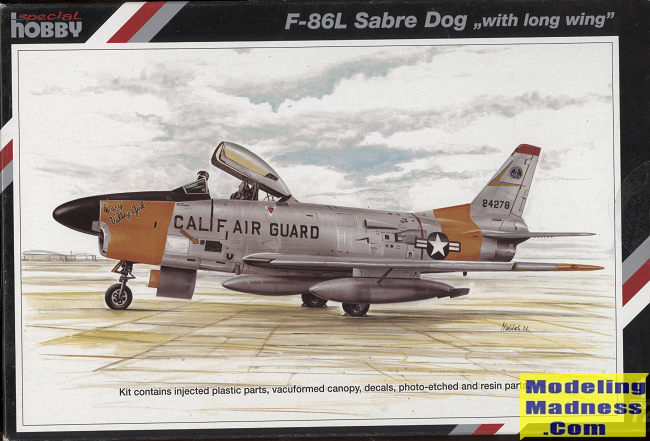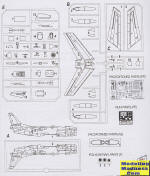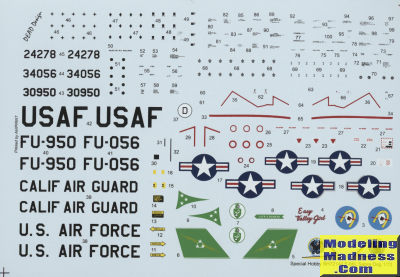
| KIT #: | SH 72144 |
| PRICE: | Approx $25-30.00 |
| DECALS: | Three options |
| REVIEWER: | Scott Van Aken |
| NOTES: | Short run with photo etch, vacuform, and resin parts |

| HISTORY |
The F-86L was the designation given to late-1950s conversions of existing USAF F-86Ds to use the Semi-Automatic Ground Environment (SAGE) datalink system.
The SAGE system was developed during the early 1950s by the Massachusetts Institute of Technology's Lincoln Laboratory. It was based on the use of a large, high-speed ground-based computer to handle and coordinate air surveillance data from various ground radar installations. This information was transmitted in real-time to a special data receiver aboard the interceptor, and an on-board system converted this data into heading, speed, altitude, target bearing, and range information that would be used to guide the pilot in his interception. No voice instructions were used, and the interceptor was automatically positioned for a lead-collision attack with its own E-4 fire control system.
In the mid 1950s, it was decided to adapt the F-86D to the new SAGE system, and in 1956, 2192 conversion kits were ordered for the F-86Ds of the Air Defense Command (ADC). Under a project code-named Project Follow-On, starting in May of 1956, certain low-time F-86D interceptors were withdrawn one-by-one from service and fitted with the upgrade. This work was done at North American plants in Fresno and Inglewood, California. Following the upgrade, they were redesignated F-86L. All F-86L block designations were changed to reflect their original F-86D block numbers. The F-86D-10 to F-86D-45 became F-86L-11 to F-86L-46, but blocks 50, 55, and 60 just changed the type from D to L, that is, the F-86D-50 became F-86L-50.
When F-86Ds were upgraded to the F-86L configuration, an AN/ARR-39 datalink receiver was fitted, which had a blade-like antenna sticking out of the fuselage just forward of and below the starboard wing. The AN/ARC-27 command radio of the F-86D was replaced by an AN/ARC-34 set. An AN/APX-25 identification radar was added, and a new AN/ARN-31 glide slope receiver was provided.
All Follow-On aircraft were brought up to F-86D-45 standards before starting with the electronics upgrades, including the installation of the drag chute in the tail. In the F-86L, two protruding cooling air intakes were added to the fuselage sides just aft of the wing, replacing the older recessed cooling ducts. The same J47-GE-33 or J47-GE-17B engine of the F-86D was retained, but the F-86L was fitted with the F-86F-40 wing, with twelve-inch wingtip extensions and "6-3" leading edge extensions with slats. The wingspan and wing area were 39.1 feet and 313.37 square feet respectively. The new wing improved the handing ability and provided better turning at high altitudes. The reconditioned F-86Ls retained the armament of twenty-four rockets of the F-86D.
The first flight took place on December 27, 1955. That particular aircraft had just the SAGE equipment installed, and the first conversion incorporating all of the Follow-On changes did not fly until May of 1956. A total of 981 F-86Ds were modified to the F-86L configuration. After conversion in 1956-57, F-86Ls were issued to most of the ADC wings that were using the F-86D. First to receive the F-86L was the 317th FIS at McChord AFB, which first received the planes in late November of 1956. The service of the F-86L with the ADC was destined to be quite brief, since by the time the last F-86L conversion was delivered, the type was already being phased out in favor of the Convair F-102A and F-106A delta-winged interceptors. The last F-86Ls left ADC service by 1960.
As F-102A and F-106A interceptors became available to the ADC, the F-86Ls were transferred to Air National Guard units beginning in late 1957. The first ANG squadron to receive the F-86L was the 108th, based at O'Hare Field in Chicago. The following ANG squadrons got F-86Ls: 108, 111, 124, 127, 128, 133, 146, 147, 151, 156, 157, 158, 159, 173, 181, 182, 185, 187, 190, 191, 192, 194, 197, and 199.
During the Cuban Missile Crisis of 1962, six ANG F-86L squadrons were on alert. The last F-86Ls were withdrawn from ANG service during the summer of 1965.
| THE KIT |
 Special
Hobby is known for getting a lot of mileage out of its kits and so it is
with this one. Released in several boxings as the F-86K, they have simply
replaced the K fuselage with the D version. Both the long and short span
wings are there so if you wanted to do an F-86D, you could well do so (aside
from the early 'sugar scoop' tail versions).
Special
Hobby is known for getting a lot of mileage out of its kits and so it is
with this one. Released in several boxings as the F-86K, they have simply
replaced the K fuselage with the D version. Both the long and short span
wings are there so if you wanted to do an F-86D, you could well do so (aside
from the early 'sugar scoop' tail versions).  Instructions
are well done and provide guidance where needed as well as cockpit color
information. Gear wells should be green chromate. A full color painting
guide provides three options. All the options start with unpainted metal and
an olive drab nose antiglare panel with a black radome. First is the box art
plane from the 194 FIS, California ANG in 1960. This plane has a red fin tip
and large da-glo patches on the nose, rear fuselage and wing tips. Second
uses the green decals and was with the 49th FIS in 1956. Note that the green
tips with flash on the drop tanks will have to be painted. The last option
is with the 83rd FIS in 1957. This aircraft has a blue stripes on the
fin and a blue lower nose section. Both of these areas will require painting
as no decals are provided for these markings. However, the large fin badge
is on the sheet. There is also a full stencil placement guide.
Instructions
are well done and provide guidance where needed as well as cockpit color
information. Gear wells should be green chromate. A full color painting
guide provides three options. All the options start with unpainted metal and
an olive drab nose antiglare panel with a black radome. First is the box art
plane from the 194 FIS, California ANG in 1960. This plane has a red fin tip
and large da-glo patches on the nose, rear fuselage and wing tips. Second
uses the green decals and was with the 49th FIS in 1956. Note that the green
tips with flash on the drop tanks will have to be painted. The last option
is with the 83rd FIS in 1957. This aircraft has a blue stripes on the
fin and a blue lower nose section. Both of these areas will require painting
as no decals are provided for these markings. However, the large fin badge
is on the sheet. There is also a full stencil placement guide.
| CONCLUSIONS |
Other than the Hasegawa and even older Airfix F-86D, the Sabre Dog has not been well catered to by mainstream model companies. These from Special Hobby will not be easy builds, especially if you add all the vortex generators. However, the finished product will look nice on the shelf.
| REFERENCES |
http://www.joebaugher.com/usaf_fighters/p86_18.html
Maiy 2019
Copyright ModelingMadness.com. All rights reserved.
Thanks to me for picking this one up when it was on sale.
If you would like your product reviewed fairly and quickly, please contact the editor or see other details in the Note to Contributors.